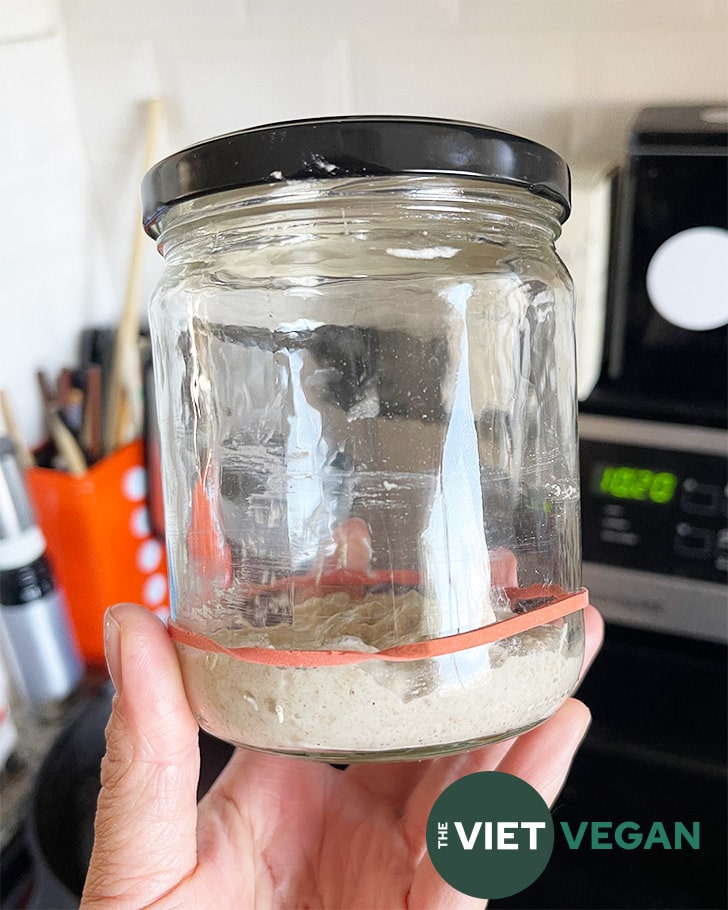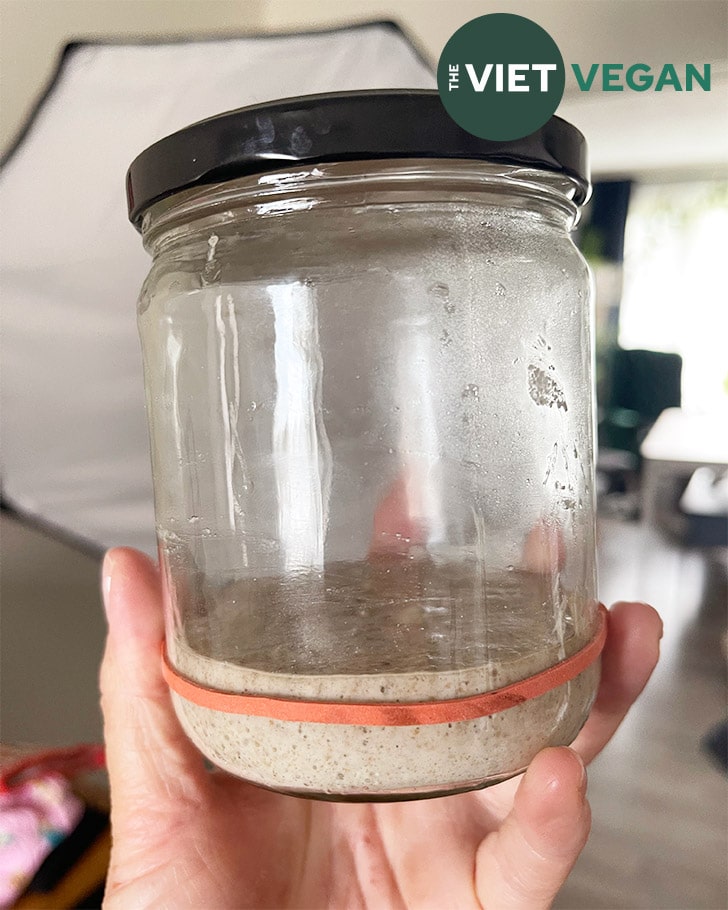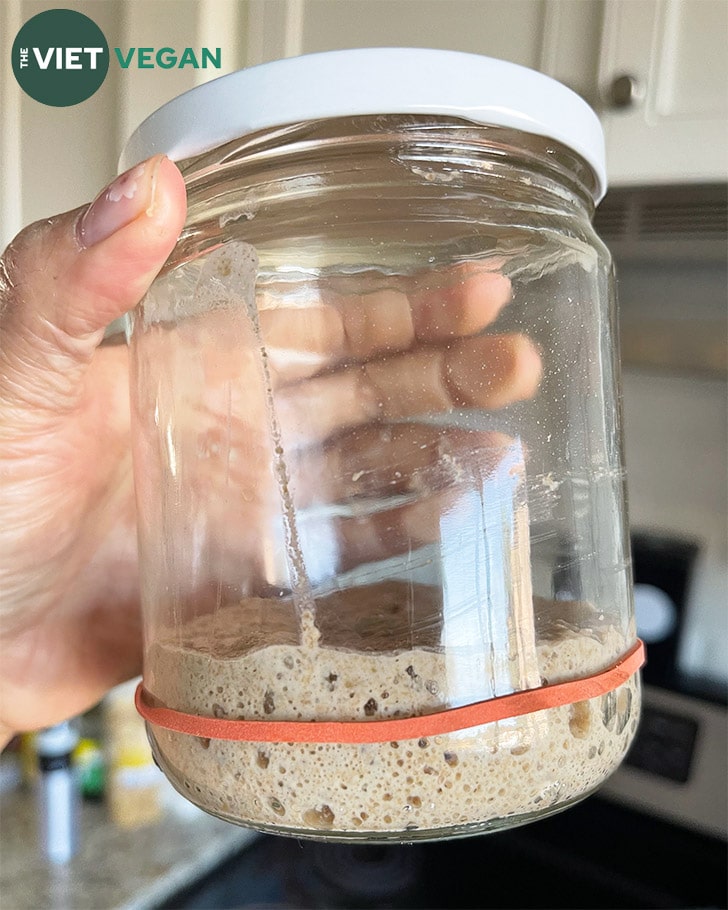
Today I’m breaking down how I store my sourdough starter in the fridge for several months, untouched, and how I revive it to make delicious sourdough bread again!
Making sourdough can be time consuming, If you need to take a break from sourdough, you don’t need to throw out your starter! Here’s what I do to store mine in the fridge:
How to store sourdough starter in the fridge to hibernate long term
I use a clean jar with an airtight lid. I use the same kinds of jars for when I store my sourdough on the counter. These are old gelato jars I get from my zero-waste bulk shop! But you can use any jar, it’s easier with a wide mouth jar!
With the new, clean jar, I create a sourdough starter feed of my usual ratio of 1:5:5 (5 g mature starter, 25 g flour mix, and 25 g water). Then, let it sit on the counter for about 6-8 hours for the yeast to multiply. I’ve also just fed the starter, and then immediately stuck it in the fridge. However, I find that my starter bounces back a bit better and is less angry at me if I let it feed a little bit before going in the fridge.
Either way, I stick it in the fridge with the lid on airtight. If my jar was more than 50% full, I’d leave the lid on more loosely, but since it’s only 20% full, there’s lots of room for it to expand.

How long can you store sourdough starter in the fridge?
Leave your starter in the fridge for as long as you want. I’ve left it in there before for 1 week; 2 months; and just recently; I pulled Carter the Starter out of the fridge after being dormant and untouched for 4 months. I’ve heard of people leaving it in there and still being able to wake up their starter after a year!
The older your starter is, the more resilient it is. So personally, I think it’s better to hibernate your old starter than to throw it out and start from scratch.

How to wake up my starter from being in the fridge:
First, I pour off the grey liquid I see on top. That liquid is the alcohol produced from long-term fermentation. Actually I take it as a good sign, that the culture is still active! But it also means it’s hungry, which is fine, because next we feed it!
I take a new, clean jar and take 5 g of the hungry starter, then feed it my usual 1:5:5 ratio of starter:water:flour mix. My flour mix is 40% rye, 40% bread flour, 20% whole wheat. Feed your starter whatever you normally feed it, be it rye, bread flour, or all purpose!
So feed your starter whatever ratio you normally feed your starter; be it 1:3:3, 1:4:4, whatever works!
So your newly fed starter will sit in a warm place on your counter for the next 12 hours. If it doubles, I discard all but 5g again, and feed my usual 1:5:5 ratio. After 24 hours, it has doubled and has a lot of bubbly activity, which tells me yeast and bacteria production is back to normal! It should smell pleasantly nice and sour.
Can you eat the discard from the fridge?
When your starter is cold, the bacteria will continue to grow, but the yeast production is halted. So depending on how long your starter has been dormant in the fridge, it’ll be a little TOO probiotic for your digestive system.
Compost or throw out the remainder of hungry starter from the fridge: I would not recommend cooking with it if it’s been in the fridge for longer than a week.

How do I know when my starter is ready to bake with?
Depending on the age of your starter, it should be able to bounce back within a day or two. If you find it’s not doubling or getting nice and bubbly, give it more time to ferment.
Since I feed mine 1:5:5, I felt safe to let it ferment to 24 hours, but if you typically feed a 1:3:3 or 1:4:4 ratio, you can probably discard and feed again at the 12 hour mark. Then use your starter as you normally do.
Something not quite right with your starter?
If you find your sourdough has some funky smells or isn’t doing what it’s supposed to do, I wrote a post all about troubleshooting my sourdough starter if you’d like to see what issues I had with mine and what I did to fix it. I also wrote all about how I made Carter the Starter in the first place!
It was a bit of a round-about method because I was following King Arthur Baking’s recipe for sourdough starter. It didn’t quite work so I had to change tactics half-way through. I did write what I would have done differently if I had to start over! It was a very long and detailed post, so have a read if you need help with your starter.

I kept the discard from 36 hrs + 48 hrs feeding to make a loaf of bread! You can try my go-to sourdough bread recipe, I use a combination of bread flour and whole wheat. I’ve made it multiple times with discard straight from the fridge.
Need more help?
I’m definitely not an expert, but I’ve had Carter the Starter for almost a year now, and baked several dozen successful loaves of bread! I’ve tried so many different methods, flour combinations, and inclusions. I feel pretty confident in my ability to troubleshoot and read sourdough bread now.
Feel free to leave a comment with your questions (or you can reach out to me on Instagram for a more timely answer) and I’ll try to help if I can! Good luck, and happy baking 🙂
Spread the love:
